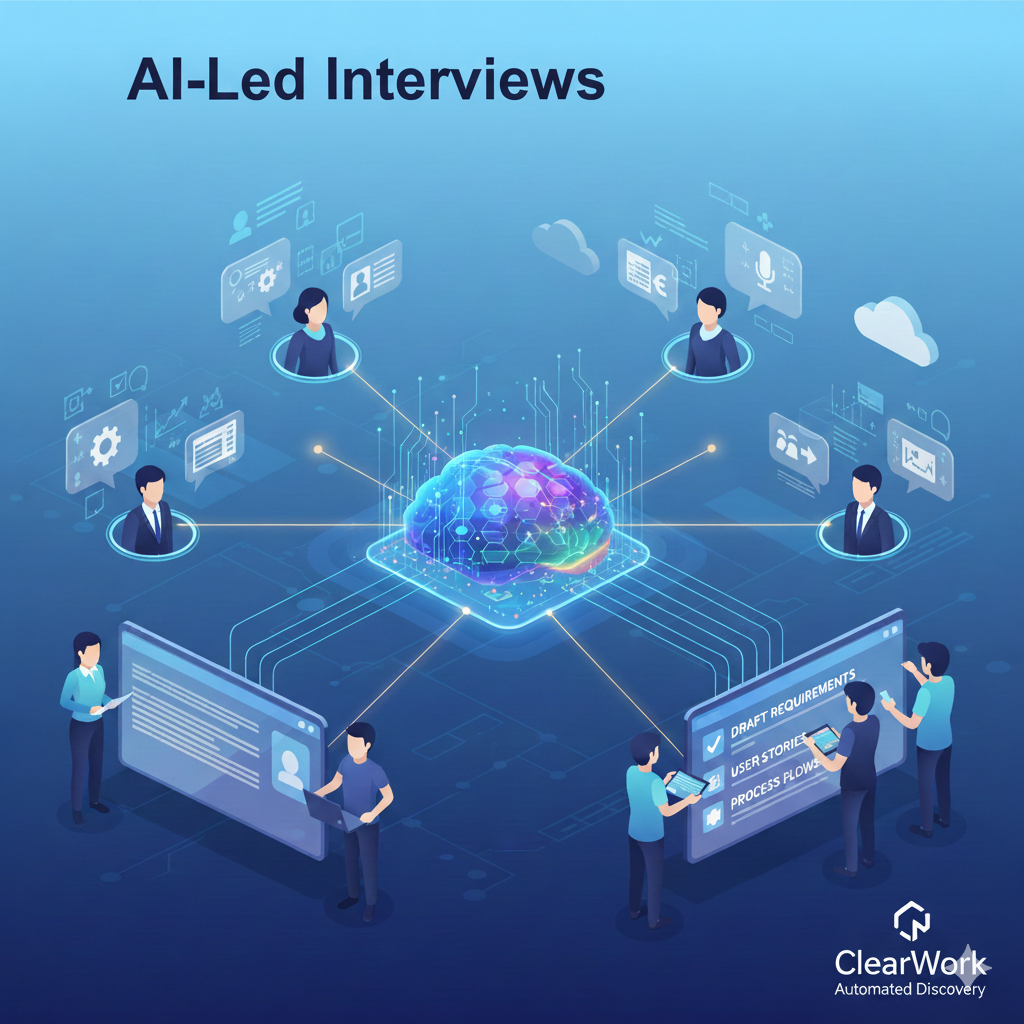
ERP, CRM and any large technology project lives or dies in the discovery phase. The accuracy, completeness, and clarity of stakeholder input determine whether the implementation launches smoothly—or spirals into rework, missed requirements, and late-stage redesign.
But the way most consulting firms collect stakeholder input hasn’t changed in 20+ years.
Workshops. Interviews. More workshops. Email follow-ups. Tribal knowledge. Transcripts. Notes.
It’s slow, manual, incomplete, and heavily dependent on who shows up and how prepared they are.
Today, AI-led stakeholder interviews offer a better model: faster, more inclusive, more consistent, and far more complete.
This article is a spoke within our broader discovery and requirements framework. For the full methodology, see the pillar post:
👉 Automated Discovery & Requirements for ERP/CRM Projects
Let’s explore how AI is transforming this foundational part of ERP/CRM work.
Stakeholder interviews are the backbone of ERP/CRM discovery because they help consultants uncover:
Research shows stakeholder interviews drive alignment, surface assumptions, and uncover critical requirements that documentation alone never reveals.
But the traditional interview model is no longer keeping up with the complexity and pace of today’s enterprise implementations.
Technology projects span functions—finance, sales, procurement, service, supply chain, IT.
Getting the right SMEs in the same room delays discovery by weeks.
Workshops favor vocal participants.
Frontline or regional teams often get missed.
Important exceptions never surface.
Consultants interpret instead of capture.
Transcripts get lost.
Insights get diluted or mis-remembered.
Sales tells their story three times.
Finance repeats definitions.
IT re-explains integrations.
By the time interviews complete, teams already need clarifications, corrections, and rework.
Stakeholder input is essential—but the process used to gather it is fundamentally outdated.
AI-led interviews don’t replace human insight—they replace administrative overhead, scheduling bottlenecks, and inconsistent documentation.
Here’s how.
Instead of trying to book 10 people across 4 departments, AI delivers guided question flows that SMEs can complete:
This eliminates the #1 delay in discovery: calendar logistics.
AI tailors questions based on:
Unlike static workshop templates, AI is adaptive and tailored to your specific organization.
Every input—text responses, audio, video, screen recordings—gets processed into structured insights:
AI identifies:
This is one of the biggest gains: the AI extracts meaning without consultants spending hours transcribing and interpreting interviews.
The AI synthesizes all stakeholder inputs into:
Consultants review → refine → validate.
They start with structure, not with a blank page.
AI makes it easy to include:
This eliminates blind spots that lead to scope creep, misalignment, and late-stage surprises.
This is a practical blueprint consulting firms can adopt immediately.
Identify:
Group them by ERP/CRM workstream or persona.
Questions should explore:
SMEs complete flows on their own schedule—dramatically increasing participation and input quality.
Outputs include:
This becomes the foundation for validation.
Workshops become about:
Not about “collecting information.”
AI does the gathering.
Consultants do the guiding.
Top consulting firms track:
When done well, AI-driven interviews consistently reduce discovery timelines by 40–60%.
AI needs strong inputs.
Stakeholders need reassurance that AI is a helper—not a surveillance tool.
AI accelerates insight, but consultant validation governs accuracy.
Interview insights must flow into Jira, Azure DevOps, or requirements management systems.
This is where ClearWork fits naturally.
ClearWork delivers:
It’s the simplest way for consulting firms to modernize discovery and gather richer, faster, and more complete stakeholder input.
👉 Explore the platform: https://www.clearwork.io/clearwork-automated-discovery
And revisit the larger framework in our pillar post:
👉 Automated Discovery & Requirements for ERP/CRM Projects
https://www.clearwork.io/blog-posts/automated-discovery-requirements-for-erp-crm-projects-a-modern-guide-for-consulting-firms
They uncover processes, exceptions, data needs, and pain points that no documentation or system analysis can reveal.
Scheduling and manual documentation slow the process and lead to incomplete or inaccurate inputs.
AI drives asynchronous interviews, adapts questions to responses, summarizes transcripts, extracts themes, and generates draft requirements automatically.
No—AI accelerates information gathering; consultants validate, guide decisions, and align stakeholders.
ClearWork automates the full interview workflow—from guided questioning to requirements generation—cutting discovery timelines by 40–60% while improving completeness.

Traditional stakeholder interviews slow discovery and create incomplete inputs that weaken downstream design. AI-led interviews make the process faster, more consistent, and far more inclusive by enabling asynchronous input, adaptive questioning, and instant summarization into requirements and user stories. If you’re ready to modernize how you capture stakeholder insight, explore how ClearWork Automated Discovery enables this new model.
Enjoy our newsletter!